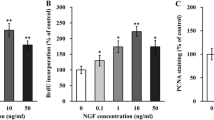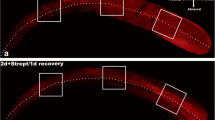Abstract
Cochlear hair cells are the sensory receptors of the auditory system. It is well established that antibiotic drugs such as gentamicin can damage hair cells and cause hearing loss. Rescuing hair cells after ototoxic injury is an important issue in hearing recovery. Although many studies have indicated a positive effect of low-level laser therapy (LLLT) on neural cell survival, there has been no study on the effects of LLLT on cochlear hair cells. Therefore, the aim of this study was to elucidate the effects of LLLT on hair cell survival following gentamicin exposure in organotypic cultures of the cochlea of rats. The cochlea cultures were then divided into a control group (n = 8), a laser-only group (n = 8), a gentamicin-only group (n = 8) and a gentamicin plus laser group (n = 7). The control cultures were allowed to grow continuously for 11 days. The laser-only cultures were irradiated with a laser with a wavelength of 810 nm at 8 mW/cm2 for 60 min per day (0.48 J/cm2) for 6 days. The gentamicin groups were exposed to 1 mM gentamicin for 48 h and allowed to recover (gentamicin-only group) or allowed to recover with daily irradiation (gentamicin plus laser group). The hair cells in all groups were stained with FM1-43 and counted every 3 days. The number of hair cells was significantly larger in the gentamicin plus laser group than in the gentamicin-only group. The number of hair cells was larger in the laser-only group than in the control group, but the difference did not reach statistical significance. These results suggest that LLLT may promote hair cell survival following gentamicin damage in the cochlea. This is the first study in the literature that has demonstrated the beneficial effect of LLLT on the recovery of cochlear hair cells.





Similar content being viewed by others
References
FDA (2009) Application K081166. Food and Drug Administration, Rockville, MD
FDA (2002) Application K020657. Food and Drug Administration, Rockville, MD
FDA (2003) Application K030226. Food and Drug Administration, Rockville, MD
FDA (2010) Application K091496. Food and Drug Administration. Silver Spring, MD
Dincer U, Cakar E, Kiralp MZ, Kilac H, Dursun H (2009) The effectiveness of conservative treatments of carpal tunnel syndrome: splinting, ultrasound, and low-level laser therapies. Photomed Laser Surg 27(1):119–125. doi:10.1089/pho.2008.2211
Oron A, Oron U, Chen J, Eilam A, Zhang C, Sadeh M, Lampl Y, Streeter J, DeTaboada L, Chopp M (2006) Low-level laser therapy applied transcranially to rats after induction of stroke significantly reduces long-term neurological deficits. Stroke 37(10):2620–2624. doi:10.1161/01.STR.0000242775.14642.b8
Detaboada L, Ilic S, Leichliter-Martha S, Oron U, Oron A, Streeter J (2006) Transcranial application of low-energy laser irradiation improves neurological deficits in rats following acute stroke. Lasers Surg Med 38(1):70–73. doi:10.1002/lsm.20256
Lapchak PA, Salgado KF, Chao CH, Zivin JA (2007) Transcranial near-infrared light therapy improves motor function following embolic strokes in rabbits: an extended therapeutic window study using continuous and pulse frequency delivery modes. Neuroscience 148(4):907–914. doi:10.1016/j.neuroscience.2007.07.002
Naeser MA, Saltmarche A, Krengel MH, Hamblin MR, Knight JA (2011) Improved cognitive function after transcranial, light-emitting diode treatments in chronic, traumatic brain injury: two case reports. Photomed Laser Surg 29(5)351–358. doi:10.1089/pho.2010.2814
McCarthy TJ, De Taboada L, Hildebrandt PK, Ziemer EL, Richieri SP, Streeter J (2010) Long-term safety of single and multiple infrared transcranial laser treatments in Sprague-Dawley rats. Photomed Laser Surg 28(5):663–667. doi:10.1089/pho.2009.2581
Zivin JA, Albers GW, Bornstein N, Chippendale T, Dahlof B, Devlin T, Fisher M, Hacke W, Holt W, Ilic S, Kasner S, Lew R, Nash M, Perez J, Rymer M, Schellinger P, Schneider D, Schwab S, Veltkamp R, Walker M, Streeter J (2009) Effectiveness and safety of transcranial laser therapy for acute ischemic stroke. Stroke 40(4):1359–1364. doi:10.1161/STROKEAHA.109.547547
Wong-Riley MT, Liang HL, Eells JT, Chance B, Henry MM, Buchmann E, Kane M, Whelan HT (2005) Photobiomodulation directly benefits primary neurons functionally inactivated by toxins: role of cytochrome c oxidase. J Biol Chem 280(6):4761–4771. doi:10.1074/jbc.M409650200
Huang YY, Chen AC, Carroll JD, Hamblin MR (2009) Biphasic dose response in low level light therapy. Dose Response 7(4):358–383. doi:10.2203/dose-response.09-027.Hamblin
Oron U, Ilic S, De Taboada L, Streeter J (2007) Ga-As (808 nm) laser irradiation enhances ATP production in human neuronal cells in culture. Photomed Laser Surg 25(3):180–182. doi:10.1089/pho.2007.2064
Zheng JL, Gao WQ (1996) Differential damage to auditory neurons and hair cells by ototoxins and neuroprotection by specific neurotrophins in rat cochlear organotypic cultures. Eur J Neurosci 8(9):1897–1905
Kim JB, Jung JY, Ahn JC, Rhee CK, Oh YH (2009) Preventive and therapeutic effects of low level laser irradiation on gentamicin-induced vestibulotoxicity in rat utricles. Korean J Otolaryngol Head Neck Surg 52(1):19–28
Chung YW, Ahn JC, Lim ES, Kim YS, Lee SH, Lee MY, Rhee CK (2007) A promotive effect of low-level laser on hair cell regeneration following gentamicin induced ototoxicity in postnatal organotypic culture of rat utricles. Korean J Otolaryngol-Head Neck Surg 50(1):25–30
Meyers JR, MacDonald RB, Duggan A, Lenzi D, Standaert DG, Corwin JT, Corey DP (2003) Lighting up the senses: FM1-43 loading of sensory cells through nonselective ion channels. J Neurosci 23(10):4054–4065
Sommer AP, Pinheiro AL, Mester AR, Franke RP, Whelan HT (2001) Biostimulatory windows in low-intensity laser activation: lasers, scanners, and NASA’s light-emitting diode array system. J Clin Laser Med Surg 19(1):29–33. doi:10.1089/104454701750066910
Mohammed IF, Al-Mustawfi N, Kaka LN (2007) Promotion of regenerative processes in injured peripheral nerve induced by low-level laser therapy. Photomed Laser Surg 25(2):107–111. doi:10.1089/pho.2006.1090
Freeman S, Geal-Dor M, Sohmer H (1999) Development of inner ear (cochlear and vestibular) function in the fetus-neonate. J Basic Clin Physiol Pharmacol 10(3):173–189
Acknowledgment
This research was supported by the Basic Science Research Program through the National Research Foundation of Korea (NRF) funded by the Ministry of Education, Science and Technology (2010–0024301).
Conflicts of Interest
None.
Author information
Authors and Affiliations
Corresponding author
Rights and permissions
About this article
Cite this article
Rhee, CK., He, P., Jung, J.Y. et al. Effect of low-level laser therapy on cochlear hair cell recovery after gentamicin-induced ototoxicity. Lasers Med Sci 27, 987–992 (2012). https://doi.org/10.1007/s10103-011-1028-5
Received:
Accepted:
Published:
Issue Date:
DOI: https://doi.org/10.1007/s10103-011-1028-5




